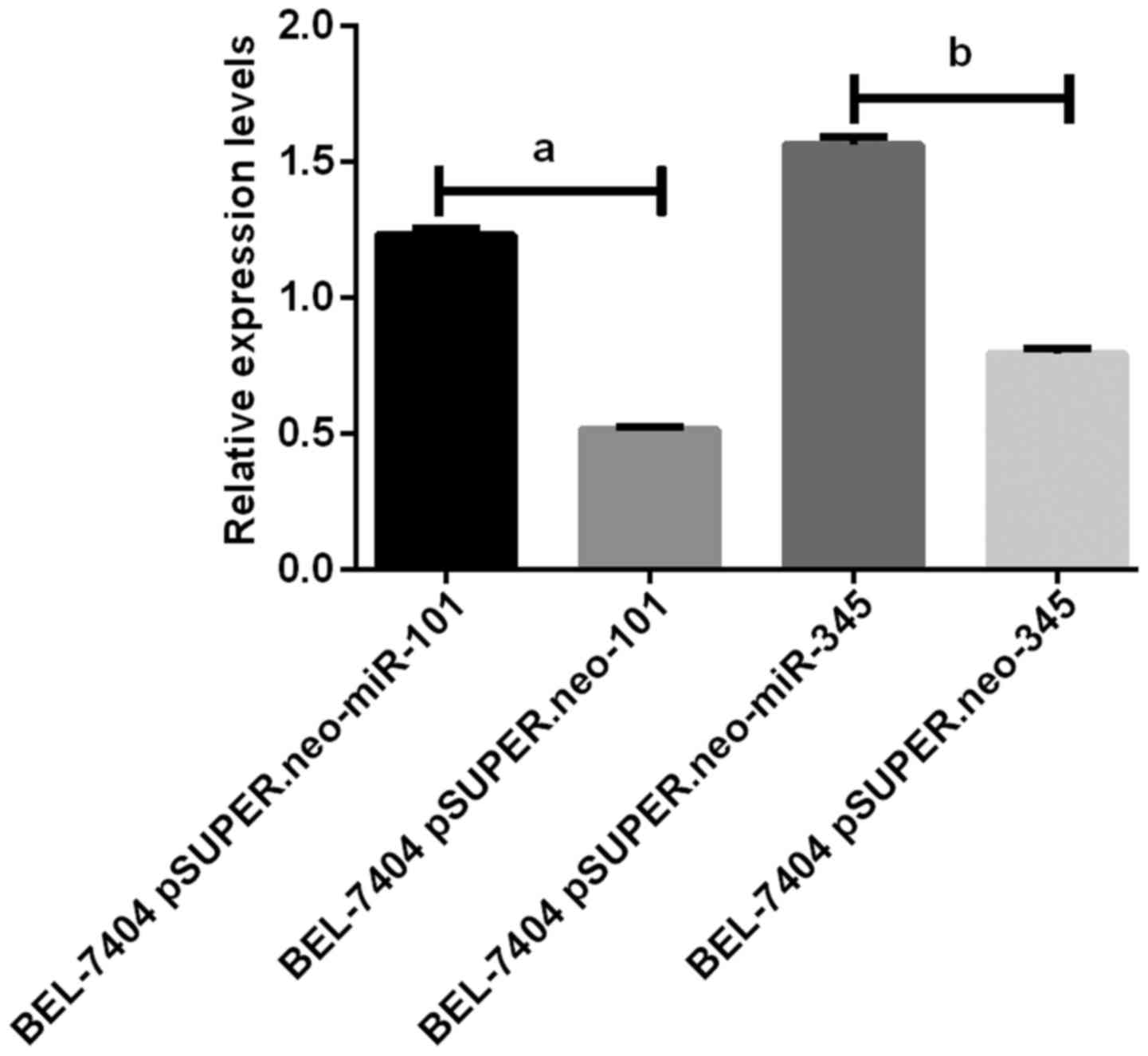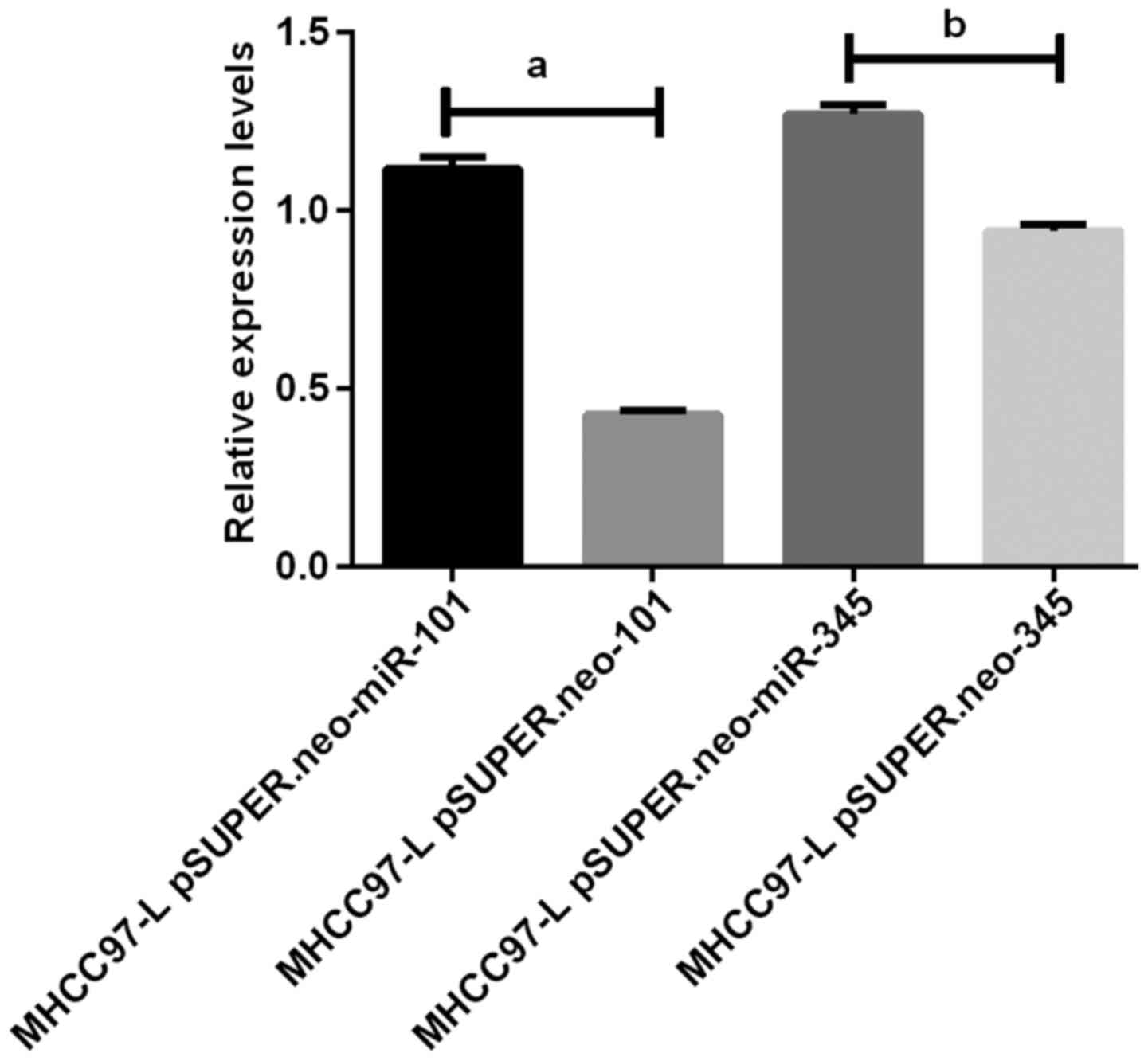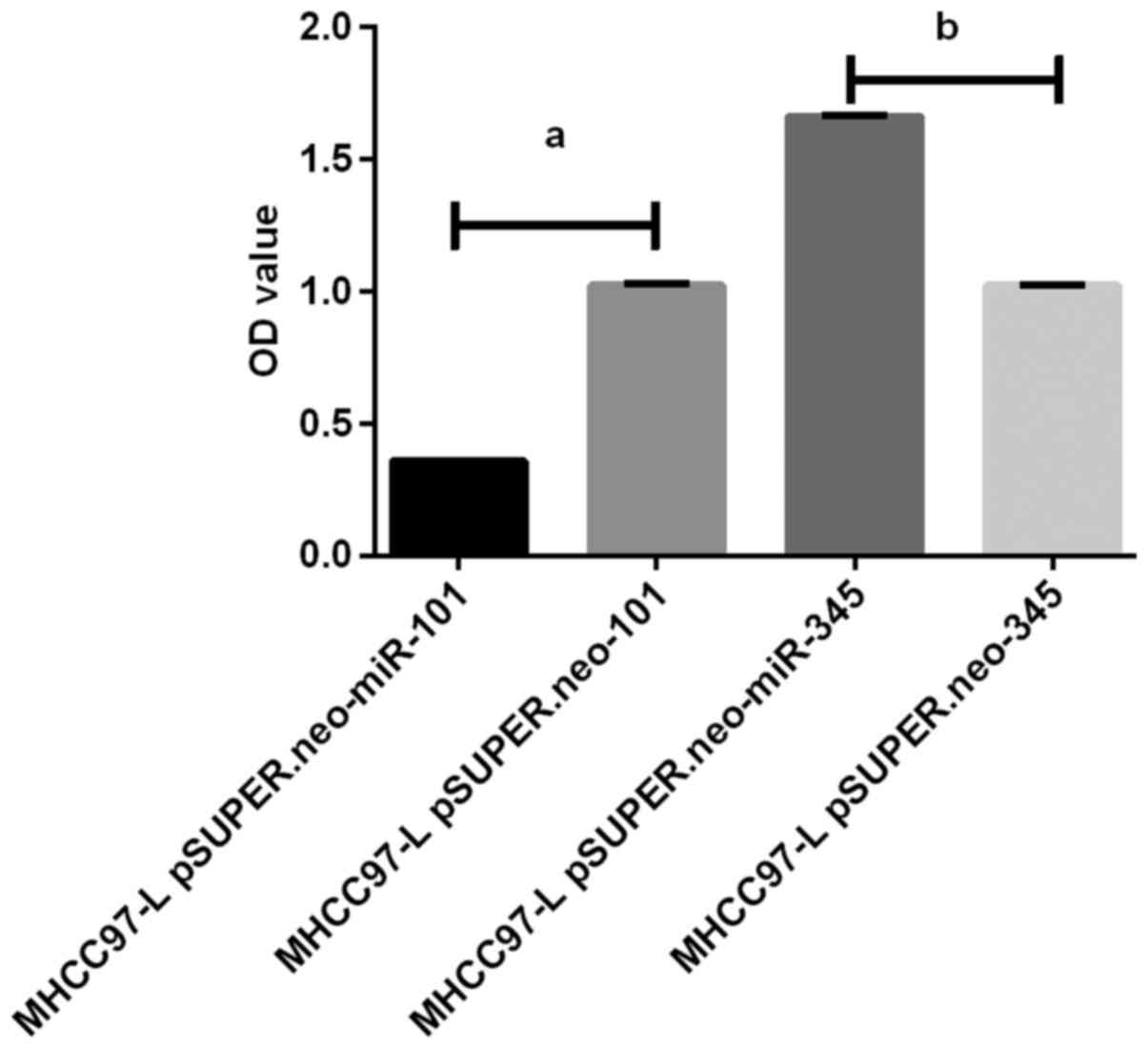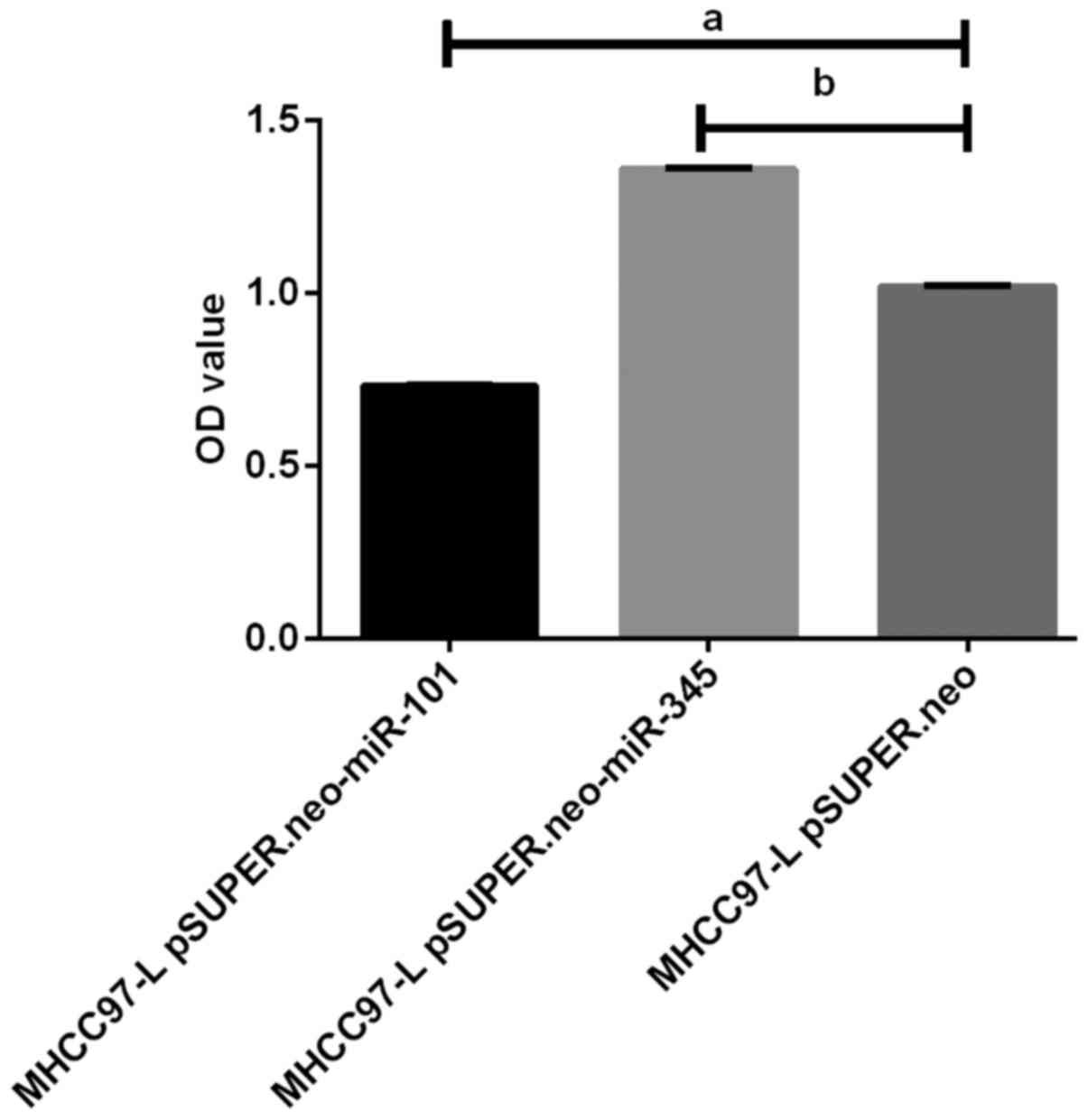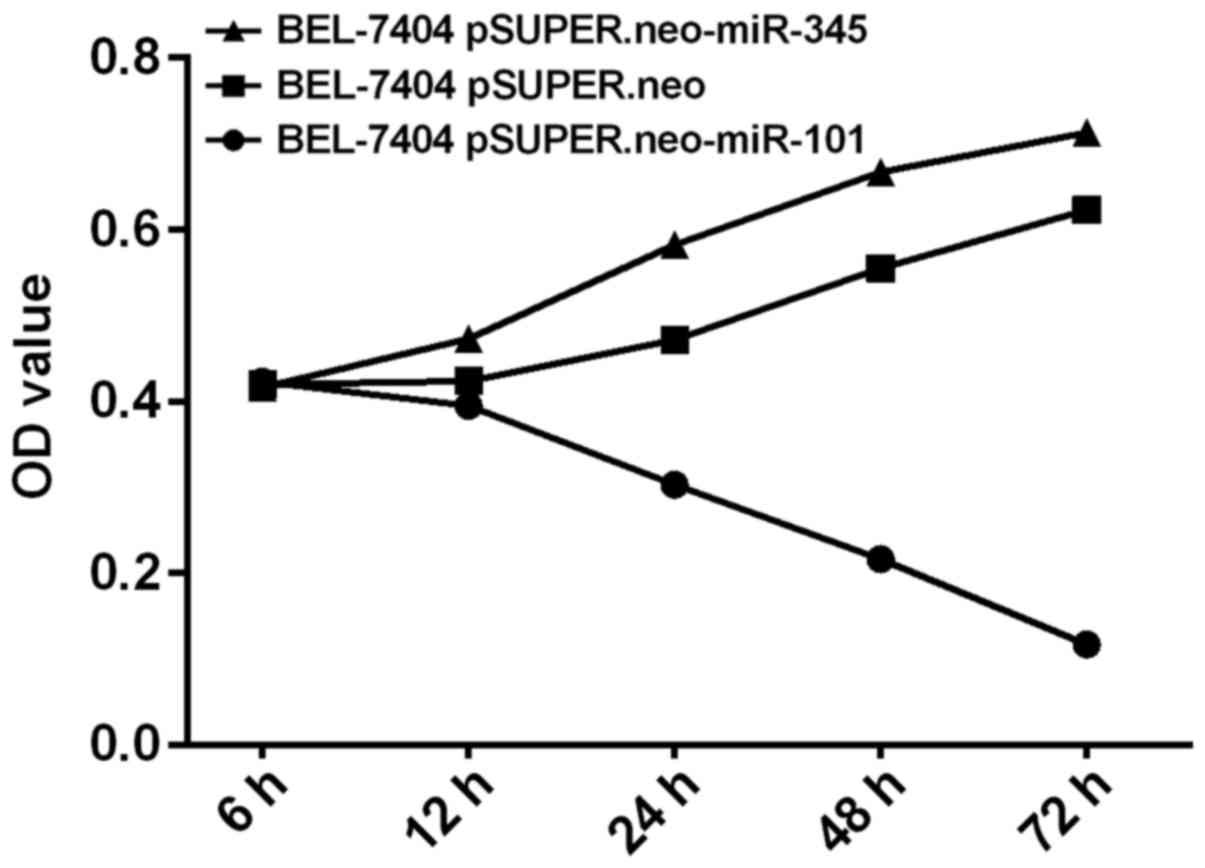Introduction
Hepatitis B is a worldwide major infectious disease,
mainly caused by hepatitis B virus (HBV) infection and manifested
as liver damage (1). Previous
findings have shown that there are approximately 400 million
HBsAg-positive individuals in the world, of which China is a
country with a high incidence of HBV, and approximately 120 million
individuals are affected (2). Many
liver cancers are associated with HBV infection. HBV enters the
hepatocytes and destroys the DNA in the hepatocytes, causing
cirrhosis of the liver and developing into liver cancer (3). Some studies have shown that the
incidence of HBV-related liver cancer is approximately 80% of the
incidence of liver cancer (4).
Domestic and foreign scholars have conducted extensive and in-depth
research on liver cancer, but the relationship between the
development of liver cancer and HBV has not been studied clearly
(5,6).
miRNAs are widely expressed in eukaryotic cells and
regulate cell proliferation, differentiation and apoptosis, while
abnormal changes in miRNA biosynthesis are involved in many
pathophysiological processes (7,8). Previous
findings have shown that many virus replication and proliferation
are closely related to the expression level of miRNA. Wei et
al reported that HBV protein can downregulate the expression of
miR-101 (9). Shiu et al also
found in the study that the expression of hepatitis C virus protein
can enhance the expression of miR-345 (10). However, the correlation between HBV
replication and miR-101 and miR-345, as well as the effects of
miR-101 and miR-345 on the growth of hepatoma cells have yet to be
fully elucidated.
Therefore, in this study, MHCC97-L and BEL-7404
cells were, respectively, used to replicate the HBV-associated
liver cancer model and non-HBV replication liver cancer model, in
order to explore the effect of miR-101 and miR-345 on HBV
replication and hepatoma cell growth.
Materials and methods
BEL-7404 (STR is 5 ‘TTAGGG-3’) and MHCC97-L were
both purchased from Shanghai Aolu Biotechnology Co., Ltd.,
Shanghai, China (cat nos. XFS3110, XFS3388, respectively) and
proliferated in DEME medium (Shanghai Saily Biotechnology Co.,
Ltd., Shanghai, China) containing 15% fetal bovine serum. BEL-7404
and MHCC97-L cell culture condrated in DEME medium (Shanghai Saily
Biotechnology Co., Ltd.; www.sailybio.com) containing 15% fetal bovine serum.
BEL-7404 and MHCC97-L cell culture conditions were 37°C constant
temperature, pH 6.8–7.4, and 5% CO2. The miR-101 and miR-345
expression vectors were constructed by Shanghai Genepharma
Pharmaceutical Co., Ltd. (Shanghai, China), including
pSUPER.neo-miR-101 and pSUPER.neo-miR-345. The constructed vector
and pSUPER.neo and trypsinized BEL-7404 and MHCC97-L were added
into DMEM medium, and replaced every 24 h for two weeks. The eight
groups obtained were: BEL-7404 pSUPER.neo-miR-101, BEL-7404
pSUPER.neo-miR-345, BEL-7404 pSUPER.neo-101, BEL-7404
pSUPER.neo-345, MHCC97-L pSUPER.neo-miR-101, MHCC97-L
pSUPER.neo-miR-345, MHCC97-L pSUPER.neo-101, and MHCC97-L
pSUPER.neo-345 groups. Lipofectamine® 2000 transfection
reagent was purchased from Shanghai Hengfei Biotechnology Co.,
Ltd., Shanghai, China (cat no. 11668019).
The study was approved by the Ethics Committee of
Jinan Infectious Disease Hospital (Jinan, China).
Total cell miRNA extraction by TRIzol
reagent
Total RNA was extracted from BEL-7404 and MHCC97-L
cells using TRIzol reagent (Shanghai Mingjin Biotech Co., Ltd.,
Shanghai, China; www.mjswkj.cn). The procedure was
performed according to the protocol. UV spectrophotometer (Bio-Rad
Laboratories, Inc., Hercules, CA, USA) was used to analyze the
concentration and purity of RNA extracted, and 3% agarose gel
electrophoresis was used to analyze RNA integrity.
miRNA RT-qPCR reaction
Following extraction of total miRNA cDNA synthesis
was performed by reverse transcription according to the
TaqMan® MicroRNA reverse transcription kit [Thermo
Fisher Scientific (China) Co., Ltd., Beijing, China]. Reaction
conditions for the PCR were: 37°C for 45 min and 95°C for 5 min.
The product was frozen at −20°C. A total of 20 µl cDNA was used for
the amplification reaction system. Thermocycling conditions were as
follows: pre-denaturation at 95°C and the results were analyzed by
using the 2−∆∆Cq method (11).
Primers used for the study were: miR-101: F:
5′-TACAGTACTGTGATAACTGAA-3′, and R: 5′-CTCAACTGGTGTCGTGGA-3′;
miR-345: F: 5′-GTCGTATCCAGTGCAGGGTCCGAGG-3′, and R:
5′-TATGCTGCTCGGGACCTGATCCTCA-3′; and the results were analyzed by
using the 2−∆∆Cq method. Primers used for the study
were: miR-101: F: 5′-TACAGTACTGTGATAACTGAA-3′, and R:
5′-CTCAACTGGTGTCGTGGA-3′; miR-345: F:
5′-GTCGTATCCAGTGCAGGGTCCGAGG-3′, and R:
5′-TATGCTGCTCGGGACCTGATCCTCA-3′; U6: F: 5′-CGCTTCGGCAGCACATATAC-3′,
and R: 5′-TTCACGAATTTGCGTGTCAT-3′.
qPCR detection of HBV DNA
DNA extraction kit (Guangzhou Jianlun Biotechnology
Co., Ltd.) was used to extract HBV DNA in MHCC97-L cells. The qPCR
reaction system was amplified with 20 was used as an internal
reference. All the samples were repeated in triplicate, and the
results were analyzed by using the 2−∆Cq method. The DNA
Amplification kit was purchased from Guangzhou Huayun Biotechnology
Co., Ltd., Guangzhou, China was used as an internal reference. All
the samples were repeated three times, and the results were
analyzed by using the 2−∆∆Cq method (11). The DNA Amplification kit was purchased
from Guangzhou Huayun Biotechnology Co., Ltd.
After 48 h MHCC97-L cells were transfected with
Lipofectamine 2000, and the cell culture medium was collected and
centrifuged at 3,200 × g for 5 min. The supernatant was taken as
the ELISA test sample. The specific steps referred to the
instructions of the HbsAg ELISA Test kit (Shanghai Jingkang
Bioengineering Co., Ltd., Shanghai, China). Multi-functional
microplate reader (Berthold LB943, Bad Wildbad, Germany) was used
for readings, and the OD value of each well under the wavelength of
450 nm was measured three times.
MTT assay for the measurement of
BEL-740 cells in vitro proliferation
The BEL-740 cells were prepared into singlearranged
cell suspensions. The BEL-740 cells were prepared into
single-arranged cell suspensions. The cells were routinely
inoculated in 96-well cell culture plates with DEME+10 % FBS (fetal
bovine serum). Part of the cultured cells were removed after 6 h,
and the cells were added with 20 µl of MTT (5 mg/ml; Shanghai
Lianmai Bioengineering Co., Ltd., Shanghai, China) and continued at
37°C. After incubation for 4 h, the supernatant containing
impurities was exhausted and added with dimethylsulfoxide (DMSO)
solution. After shaking for 15 min on a horizontal shaker, the
absorbance at a wavelength of 570 nm was measured by an
enzyme-linked immunosorbent assay (ELISA). The above steps were
repeated at 12, 24, 48, and 72 h of the experiment,
respectively.
Statistical analysis
SPSS 19.0 (Asia Analytics, formerly SPSS China) was
used for statistical analysis. The measurement data were expressed
as mean ± standard deviation. The non-parametric Kolmogorov-Smirnov
test was used to compare the data that did not fit the normal
distribution between the two groups. The t-test was used to compare
the data with the normal distribution. P<0.05 was considered to
indicate a statistically significant difference.
Results
RT-qPCR results
The results of RT-PCR amplification of miR-101 and
miR-345 in BEL-740 and MHCC97-L cells showed that the expression of
miR-101 and miR-345 in the BEL-740 pSUPER.neo-miR-101 and BEL-740
pSUPER.neo-miR-345 groups were significantly higher than those in
the BEL-740 pSUPER.neo-101 and BEL-740 pSUPER.neo-345 groups
(P<0.05). The expression levels of miR-101 and miR-345 in the
MHCC97-L pSUPER.neo-miR-101 and MHCC97-L pSUPER.neo-miR-345 groups
were significantly higher than those in the MHCC97-L pSUPER.neo-101
and MHCC97-L pSUPER.neo-345 groups (P<0.05) (Figs. 1 and 2).
Results of qPCR detection of HBV
DNA
HBV DNA qPCR amplification results showed that HBV
DNA expression level in MHCC97-L pSUPER.neo-miR-101 group was
significantly lower than that in MHCC97-L pSUPER.neo-101 group
(P<0.05). The HBV DNA level in MHCC97-L pSUPER.neo-miR-345 group
was significantly higher than that in MHCC97-L pSUPER.neo-345 group
(P<0.05). The HBV DNA level in MHCC97-L pSUPER.neo-miR-101 group
was significantly different from that in MHCC97-L
pSUPER.neo-miR-345 group (P<0.05) (Fig. 3).
ELISA detection of HbsAg
The results of HbsAg ELISA showed that the
expression level of HbsAg in MHCC97-L pSUPER.neo-miR-101 group was
significantly lower than that in MHCC97-L pSUPER.neo-101 group
(P<0.05). The expression of HbsAg in MHCC97-L pSUPER.neo-miR-345
group was significantly higher than that in MHCC97-L pSUPER.neo-345
group (P<0.05). The expression of HbsAg in MHCC97-L
pSUPER.neo-miR-101 group was significantly different from that in
MHCC97-L pSUPER.neo-345 group (P<0.05) (Fig. 4).
BEL-7404 cell proliferation in vitro
results using MTT assay
The proliferation of BEL-7404 cells in BEL-7404
pSUPER.neo-miR-101 group was significantly lower than that in
BEL-7404 pSUPER.neo-101 group (P<0.05) by MTT assay, and showed
a gradual downward trend. The proliferation of BEL-7404 cells in
BEL-7404 pSUPER.neo-miR-345 group was significantly higher than
that in BEL-7404 pSUPER.neo-345 group (P<0.05), and showed a
gradual upward trend. The proliferation of BEL-7404 cells in
BEL-7404 pSUPER.neo-miR-101 group was different from that in
BEL-7404 pSUPER.neo-miR-345 group (P<0.05) (Fig. 5).
Discussion
HBV is a type of hepadnavirus that has a very high
mutation rate; although it can be controlled, it cannot be
completely eliminated, and it is one of viruses which is the most
difficult to cure under present medical technology (1). HBV infection is the main cause of liver
cancer. Long-term HBV infection stimulates the body to produce a
sustained immune response, causing liver immune damage, progressing
into cirrhosis and eventually liver cancer (12,13). HBV
DNA can also be integrated into the genome of hepatocytes by
reverse transcription reactions, causing mutations in the gene and
inducing liver cancer (14).
Therefore, in this study, the effects of miR-101 and miR-345 on HBV
replication and hepatoma cell proliferation were investigated, in
order to provide clinical help for the treatment of HBV and
HBV-related liver cancer.
In this study, MHCC97-L cells and BEL-7404 cells
were respectively used to replicate the HBV-associated liver cancer
model and HBV-free liver cancer model, in order to explore the
relationship between miR-101, miR-345 and HBV replication and liver
cancer cell proliferation.
In this experiment, the expression of miR-101 and
miR-345 in MHCC97-L cells were regulated by the construction of
pSUPER.neo-miR-101 and pSUPER.neo-miR-345 expression vectors.
RT-qPCR results showed that the miR-101 expression in MHCC97-L
pSUPER.neo-miR-101 group and the miR-345 expression in MHCC97-L
pSUPER.neo-miR-345 groups was higher than that in MHCC97-L
pSUPER.neo group (P<0.05), indicating that the expression vector
was successfully constructed, and the vectors successfully
regulated the expression level of miR-101 and miR-345 in MHCC97-L
cells. We then examined the HBV DNA, and qPCR results showed that
the expression of HBV DNA in MHCC97-L pSUPER.neo-miR-101 group was
significantly lower than that in MHCC97-L pSUPER.neo group, but
MHCC97-L pSUPER.neo-miR-345 group HBV DNA expression was
significantly higher than that in MHCC97-L pSUPER.neo group,
indicating that upregulation of miR-101 expression can reduce the
expression of HBV DNA, thereby inhibiting HBV replication, and
upregulation of miR-345 expression can increase the level of HBV
DNA expression, thereby promoting HBV replication. The results of
ELISA also showed that the expression level of HbsAg in MHCC97-L
pSUPER.neo-miR-101 group was lower than that in MHCC97-L pSUPER.neo
group, while the expression level of HbsAg in MHCC97-L
pSUPER.neo-miR-345 group was higher than that in MHCC97-L
pSUPER.neo group. Although there are some studies on the
relationship between miR-101 and virus replication, the focus is
the effect of virus replication on the expression level of
miR-101.
As Sheng et al (15) reported in their study, HBV can
downregulate the expression of miR-101, and promote the
proliferation of liver cancer cells through Rab5a. Only Zheng et
al (16) reported that miR-101
inhibits herpes simplex virus-1 replication by targeting ATP5B.
This is in line with our findings. We did not examine ATP5B levels,
but we speculate that the targeted regulation of miR-101 on ATP5B
may also be a mechanism by which miR-101 regulates HBV replication.
We hope to discuss this issue in future studies. However, most
studies tend to examien hepatitis C virus (HCV) on the relationship
between miR-345 and viral replication. No studies have yet been
found on the relationship between miR-345 and HBV. Zhang et
al (17) found that miR-345
expression levels in plasma of HCV patients was 2–3-fold higher
than normal, which is similar to our result. Therefore, the
expression levels of miR-101 and miR-345 are closely related to HBV
replication.
This experiment also transfected pSUPER.neo-miR-101
and pSUPER.neo-miR-345 expression vector in BEL-7404 cells. RT-qPCR
results showed that miR-101 level in BEL-7404 pSUPER.neo-miR-101
group and miR-345 expression level in BEL-7404 pSUPER.neo-miR-345
group were higher than those in BEL-7404 pSUPER.neo group
(P<0.05); thus, miR-101 and miR-345 expression levels in
BEL-7404 cells were successfully regulated. The results of MTT test
showed that the proliferation of BEL-7404 cells in BEL-7404
pSUPER.neo-miR-101 group and BEL-7404 pSUPER.neo-miR-345 group was
significantly lower than that in BEL-7404 pSUPER.neo group
(P<0.05). The results showed that the upregulation of miR-101
and miR-345 could reduce the proliferation of BEL-7404 cells. Shen
et al (18) showed that
miR-101 acts as a tumor suppressor by directly targeting
lipoprotein kinase in liver cancer. This is similar to our results,
in which the upregulation of miR-101 can inhibit liver cancer cell
proliferation. Srivastava et al (19) also reported that the downregulation of
miR-345 expression level is conducive to pancreatic cancer cell
apoptosis. Thus, the expression levels of miR-101 and miR-345 are
closely related to the proliferation of hepatoma cells.
Du et al (20)
showed that HBV replication levels were closely related to
HBV-related hepatoma cell proliferation; reducing the level of HBV
replication can reduce the proliferation of liver cancer cells.
Therefore, through the transfection assay on MHCC97-L cell and
BEL-7404 cells, we can speculate that upregulating the expression
of miR-101 or downregulating the expression of miR-345 can reduce
the HBV replication, and thus further reduce the level of liver
cancer cells, which has a positive meaning on the treatment of
HBV-related liver cancer. However, we do not know whether miR-101
and miR-345 have the same effect on human, thus we need to obtain
further data in the clinic to verify our results.
In summary, miR-101 can reduce the level of HBV
replication and inhibit the proliferation of hepatoma cells. In
addition, miR-345 can upregulate the level of HBV replication and
promote the proliferation of liver cancer cells.
Acknowledgements
Not applicable.
Funding
No funding was received.
Availability of data and materials
The datasets used and/or analyzed during the present
study are available from the corresponding author on reasonable
request.
Authors' contributions
AD and LZ performed PCR and MTT assay. CW helped
with total cell miRNA extraction and cell culture. All authors read
and approved the final manuscript.
Ethics approval and consent to
participate
The study was approved by the Ethics Committee of
Jinan Infectious Disease Hospital (Jinan, China).
Patient consent for publication
Not applicable.
Competing interests
The authors declare that they have no competing
interests.
References
|
1
|
Liang X, Bi S, Yang W, Wang L, Cui G, Cui
F, Zhang Y, Liu J, Gong X, Chen Y, et al: Reprint of:
Epidemiological serosurvey of Hepatitis B in China - declining HBV
prevalence due to Hepatitis B vaccination. Vaccine. 31 Suppl
9:J21–J28. 2013. View Article : Google Scholar : PubMed/NCBI
|
|
2
|
Marcellin P, Gane E, Buti M, Afdhal N,
Sievert W, Jacobson IM, Washington MK, Germanidis G, Flaherty JF,
Schall Aguilar R, et al: Regression of cirrhosis during treatment
with tenofovir disoproxil fumarate for chronic hepatitis B: A
5-year open-label follow-up study. Lancet. 381:468–475. 2013.
View Article : Google Scholar : PubMed/NCBI
|
|
3
|
Ringelhan M, Heikenwalder M and Protzer U:
Direct effects of hepatitis B virus-encoded proteins and chronic
infection in liver cancer development. Dig Dis. 31:138–151. 2013.
View Article : Google Scholar : PubMed/NCBI
|
|
4
|
Singh S, Fujii LL, Murad MH, Wang Z,
Asrani SK, Ehman RL, Kamath PS and Talwalkar JA: Liver stiffness is
associated with risk of decompensation, liver cancer, and death in
patients with chronic liver diseases: a systematic review and
meta-analysis. Clin Gastroenterol Hepatol. 11(1573–1584):
e1571–1572; quiz e1588-1579. 2013.
|
|
5
|
Ringelhan M, O'Connor T, Protzer U and
Heikenwalder M: The direct and indirect roles of HBV in liver
cancer: Prospective markers for HCC screening and potential
therapeutic targets. J Pathol. 235:355–367. 2015. View Article : Google Scholar : PubMed/NCBI
|
|
6
|
Lau CC, Sun T, Ching AK, He M, Li JW, Wong
AM, Co NN, Chan AW, Li PS, Lung RW, et al: Viral-human chimeric
transcript predisposes risk to liver cancer development and
progression. Cancer Cell. 25:335–349. 2014. View Article : Google Scholar : PubMed/NCBI
|
|
7
|
Wang H, Zhang G, Wu Z, Lu B, Yuan D, Li X
and Lu Z: MicoRNA-451 is a novel tumor suppressor via targeting
c-myc in head and neck squamous cell carcinomas. J Cancer Res Ther.
11 Suppl 2:C216–C221. 2015. View Article : Google Scholar : PubMed/NCBI
|
|
8
|
Sun L, Jiang R, Li J, Wang B, Ma C, Lv Y
and Mu N: MicoRNA-425-5p is a potential prognostic biomarker for
cervical cancer. Ann Clin Biochem. 54:127–133. 2017. View Article : Google Scholar : PubMed/NCBI
|
|
9
|
Wei X, Xiang T, Ren G, Tan C, Liu R, Xu X
and Wu Z: miR-101 is down-regulated by the hepatitis B virus ×
protein and induces aberrant DNA methylation by targeting DNA
methyltransferase 3A. Cell Signal. 25:439–446. 2013. View Article : Google Scholar : PubMed/NCBI
|
|
10
|
Shiu TY, Huang SM, Shih YL, Chu HC, Chang
WK and Hsieh TY: Hepatitis C virus core protein down-regulates
p21(Waf1/Cip1) and inhibits curcumin-induced apoptosis through
microRNA-345 targeting in human hepatoma cells. PLoS One.
8:e610892013. View Article : Google Scholar : PubMed/NCBI
|
|
11
|
Livak KJ and Schmittgen TD: Analysis of
relative gene expression data using real-time quantitative PCR and
the 2(−∆∆C(T)) method. Methods. 25:402–408. 2001. View Article : Google Scholar : PubMed/NCBI
|
|
12
|
Ozen C, Yildiz G, Dagcan AT, Cevik D, Ors
A, Keles U, Topel H and Ozturk M: Genetics and epigenetics of liver
cancer. N Biotechnol. 30:381–384. 2013. View Article : Google Scholar : PubMed/NCBI
|
|
13
|
Chen WQ, Zheng RS and Zhang SW: Liver
cancer incidence and mortality in China, 2009. Chin J Cancer.
32:162–169. 2013. View Article : Google Scholar : PubMed/NCBI
|
|
14
|
Qu C, Chen T, Fan C, Zhan Q, Wang Y, Lu J,
Lu LL, Ni Z, Huang F, Yao H, et al: Efficacy of neonatal HBV
vaccination on liver cancer and other liver diseases over 30-year
follow-up of the Qidong hepatitis B intervention study: A cluster
randomized controlled trial. PLoS Med. 11:e10017742014. View Article : Google Scholar : PubMed/NCBI
|
|
15
|
Sheng Y, Li J, Zou C, Wang S, Cao Y, Zhang
J, Huang A and Tang H: Downregulation of miR-101-3p by hepatitis B
virus promotes proliferation and migration of hepatocellular
carcinoma cells by targeting Rab5a. Arch Virol. 159:2397–2410.
2014. View Article : Google Scholar : PubMed/NCBI
|
|
16
|
Zheng SQ, Li YX, Zhang Y, Li X and Tang H:
MiR-101 regulates HSV-1 replication by targeting ATP5B. Antiviral
Res. 89:219–226. 2011. View Article : Google Scholar : PubMed/NCBI
|
|
17
|
Zhang Q, Xu M, Qu Y, Li Z, Zhang Q, Cai X
and Lu L: Analysis of the differential expression of circulating
microRNAs during the progression of hepatic fibrosis in patients
with chronic hepatitis B virus infection. Mol Med Rep.
12:5647–5654. 2015. View Article : Google Scholar : PubMed/NCBI
|
|
18
|
Shen Q, Bae HJ, Eun JW, Kim HS, Park SJ,
Shin WC, Lee EK, Park S, Park WS, Lee JY, et al: MiR-101 functions
as a tumor suppressor by directly targeting nemo-like kinase in
liver cancer. Cancer Lett. 344:204–211. 2014. View Article : Google Scholar : PubMed/NCBI
|
|
19
|
Srivastava SK, Bhardwaj A, Arora S, Tyagi
N, Singh S, Andrews J, McClellan S, Wang B and Singh AP:
MicroRNA-345 induces apoptosis in pancreatic cancer cells through
potentiation of caspase-dependent and -independent pathways. Br J
Cancer. 113:660–668. 2015. View Article : Google Scholar : PubMed/NCBI
|
|
20
|
Du Y, Kong G, You X, Zhang S, Zhang T, Gao
Y, Ye L and Zhang X: Elevation of highly up-regulated in liver
cancer (HULC) by hepatitis B virus X protein promotes hepatoma cell
proliferation via down-regulating p18. J Biol Chem.
287:26302–26311. 2012. View Article : Google Scholar : PubMed/NCBI
|















